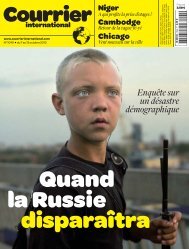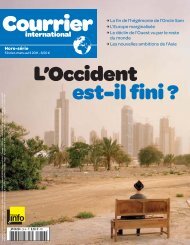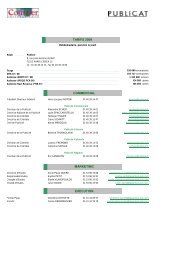2 ОРГАНИЗАЦИЯ И МЕТОДИКА РАБОТ - Courrier international
2 ОРГАНИЗАЦИЯ И МЕТОДИКА РАБОТ - Courrier international
2 ОРГАНИЗАЦИЯ И МЕТОДИКА РАБОТ - Courrier international
You also want an ePaper? Increase the reach of your titles
YUMPU automatically turns print PDFs into web optimized ePapers that Google loves.
.<br />
Table 5.2.3 Approximate rating scale of soil pollution hazard according to (Zc)<br />
Pollution class Value Zc Changes in human health in pollution focus<br />
Permissible Less than 16<br />
Moderately hazardous 16-32 The increase in general morbidity<br />
Hazardous 32-128<br />
Extremely hazardous Nore than 128<br />
The lowest level of child morbidity and minimal incidence of functional<br />
abnormalities<br />
The increase in general morbidity, the number of sickly children,<br />
children with chronic diseases, impaired functional status of the<br />
cardiovascular system<br />
The increase in child morbidity, impaired reproductive function of women<br />
(ILelichenie toxicosis of pregnancy, the number of premature births,<br />
stillbirths, infant malnutrition)<br />
The total pollution index Zc was calculated by 9 contamination parameters: manganese, zinc,<br />
copper, nickel, cobalt, lead, cadmium, chrome and mercury. The concentrations of heavy metals in<br />
the Far North regions (Taimyr Peninsula and Spitsbergen Archipelago) were used as background<br />
values according to long-term observation (Arctic Pollution Issues, AMAP Assessment Report,<br />
Norway, Oslo, Arctic Monitoring and Assessment Programme (AMAP), 1998) given in Table 5.3-<br />
4).<br />
Element<br />
Table 5.2.4 Background content of heavy metals in the Far North<br />
Background content,<br />
mg/kg<br />
Element<br />
Manganese 106.72 Lead 8.8<br />
Zinc 24.9 Cadmium 0.1<br />
Copper 8.3 Chrome 7.54<br />
Nickel 6.5 Mercury 0.1<br />
Cobalt 5.0<br />
Background content,<br />
mg/kg<br />
Evaluation of chemical contamination of soils according to <strong>international</strong> standards is performed by<br />
comparing the obtained values of the content of controlled parameters with the values of PC and IL<br />
(SP 11-102-97, Appendix B).Permissible concentration (PC) is defined as an estimated set<br />
maximum concentration of substance polluting ground that does not cause adverse direct or indirect<br />
impact on the environment and human health.<br />
Soil containing contaminants less than DC can be attributed according to the Russian classification<br />
to the category of clean acceptably polluted, with the contents higher than PC and less than the<br />
intervention level that correspond to the category of pollution from moderately polluted to<br />
hazardously polluted.<br />
When the concentrations of pollutants exceeding the intervention level (IL) are detected, soils are<br />
considered to be hazardously contaminated and referred to the third and a higher class of risks of<br />
FINAL REPORT for Contract No. CS-NPA-Arctic-13/2009 of December 01, 2009 within the framework of pilot project Development of<br />
Technology of clean up of the area of Decommissioned Sites of The Russian Federation Ministry of Defense in the Arctic by the<br />
Example of Alexanra Island of Franz Josef Land Archipelago from Hazardous Waste<br />
78








